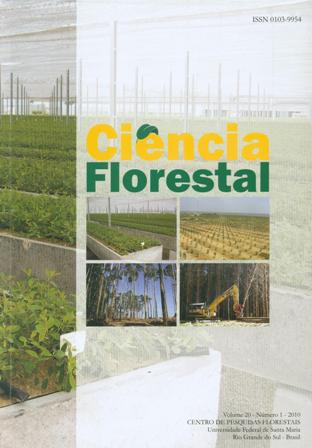Geoprocessamento como ferramenta de apoio à gerência de pavimentos em estradas florestais.
DOI:
https://doi.org/10.5902/198050981763Palabras clave:
geoprocessamento, estradas florestais, gerênciaResumen
O objetivo do trabalho foi utilizar as técnicas de geoprocessamento na aquisição, manipulação, espacialização e visualização de dados do padrão de qualidade de estradas florestais, e na confecção de mapas temáticos, com a identificação de pontos críticos para o transporte de madeira, servindo como subsídio para o desenvolvimento de um programa de manutenção preventivo e regular. Identificaram-se e avaliaram-se a integridade e as condições de operação de estradas florestais mediante levantamento contínuo de defeitos na superfície de rolamento e obtenção do ICRNP (índice de condição da rodovia não-pavimentada). A base de dados georreferenciada, a alocação das unidades amostra e a espacialização da rede viária foram obtidas com auxílio da imagem do satélite CBERS II, modelo de elevação do terreno SRTM, e GPS. A identificação e a avaliação das rodovias, por meio de levantamentos detalhados em campo, demonstraram as condições da superfície de rolamento das rodovias, gerando informações sobre os trechos mais críticos e a intensidade de cada defeito, apontando ainda ações e base de custos para manutenção das estradas florestais. As técnicas de geoprocessamento, GPS, sensoriamento remoto e SIG mostraram-se como eficientes ferramentas para a interpretação, qualificação e quantificação de fenômenos naturais da região de estudo e para auxílio na gerência de pavimentos das estradas florestais. O SIG integrou os dados referentes aos padrões de operação e manutenção das rodovias à base de dados georreferenciada, manipulando, espacializando e disponibilizando visualmente, por meio de mapas, as informações geradas.
Descargas
Citas
BAESSO, D. P.; GONÇALVES, F. L. R. Estradas rurais: técnicas adequadas de manutenção. Florianópolis: DER, 2003. 204 p.
CONFEDERAÇÃO NACIONAL DOS TRANSPORTES. Pesquisa rodoviária 2005: relatório gerencial. Brasília, 2005. Disponível em: < http://www.cnt.org.br>. Acesso em: 15 abr. 2006.
FLEURY, P. F. Gestão estratégica do transporte. Revista Tecnologística, São Paulo, v. 8, n. 82, set. 2002.
INSTITUTO BRASILEIRO DE GEOGRAFIA E ESTATÍSTICA. Brasil em números/Brazil in figures. Rio de Janeiro: IBGE, 2005. v. 13.
MACHADO, C. C.; SANTOS, S. M. A rede viária florestal. In: CONGRESSO FLORESTAL PANAMERICANO, 1.; CONGRESSO FLORESTAL BRASILEIRO, 7., 1993, Curitiba. Anais... Curitiba: SBS/SBEF, [1993]. v. 3. p. 332-336.
MACHADO, C. C.; MALINOVSKI, J. R. Rede viária florestal. Curitiba: FUPEF, 1986. 156 p.
NUNES, T. V. L. Método de previsão de defeitos em estradas vicinais de terra com base no uso das redes neurais artificiais: trecho de Aquiraz - CE. 2003. 118 f. Dissertação (Mestrado em Engenharia de Transportes) - Universidade Federal do Ceará, Fortaleza, 2003.
ODA, S. Caracterização de uma rede municipal de estradas não-pavimentadas. 1995. 176 f. Dissertação (Mestrado em Engenharia de Transportes) - Escola de Engenharia de São Carlos, São Carlos, 1995.
RHIND, D. Understanding GIS the Arc/Info method. RedLands: Environment Stems Reserch Institute, 1991. 411 p.
SANTOS, M. S.; PINA, M. F.; CARVALHO, M. S. (Org.). Conceitos de sistemas de informações geográficas e cartografia aplicados à saúde. Brasília: Organização Panamericana de Saúde, 2000.
SILVA, M. L.; JACOVINE, L. A. G.; VALVERDE, S. R. Economia florestal. Viçosa: UFV, 2002. 178 p.
VEIGA, T. C.; SILVA, J. X. Geprocessamento aplicado à identificação de áreas potenciais para atividades turísticas: o caso do município de Macaé-RJ. In: SILVA, J. X.; ZAIDAN, R. T. (Org.). Geoprocessamento e análise ambiental: aplicações. Rio de janeiro: Bertrand Brasil, 2004. p. 179-215.
Descargas
Publicado
Cómo citar
Número
Sección
Licencia
A CIÊNCIA FLORESTAL se reserva o direito de efetuar, nos originais, alterações de ordem normativa, ortográfica e gramatical, com vistas a manter o padrão culto da lingua, respeitando, porém, o estilo dos autores.
As provas finais serão enviadas as autoras e aos autores.
Os trabalhos publicados passam a ser propriedade da revista CIÊNCIA FLORESTAL, sendo permitida a reprodução parcial ou total dos trabalhos, desde que a fonte original seja citada.
As opiniões emitidas pelos autores dos trabalhos são de sua exclusiva responsabilidade.







